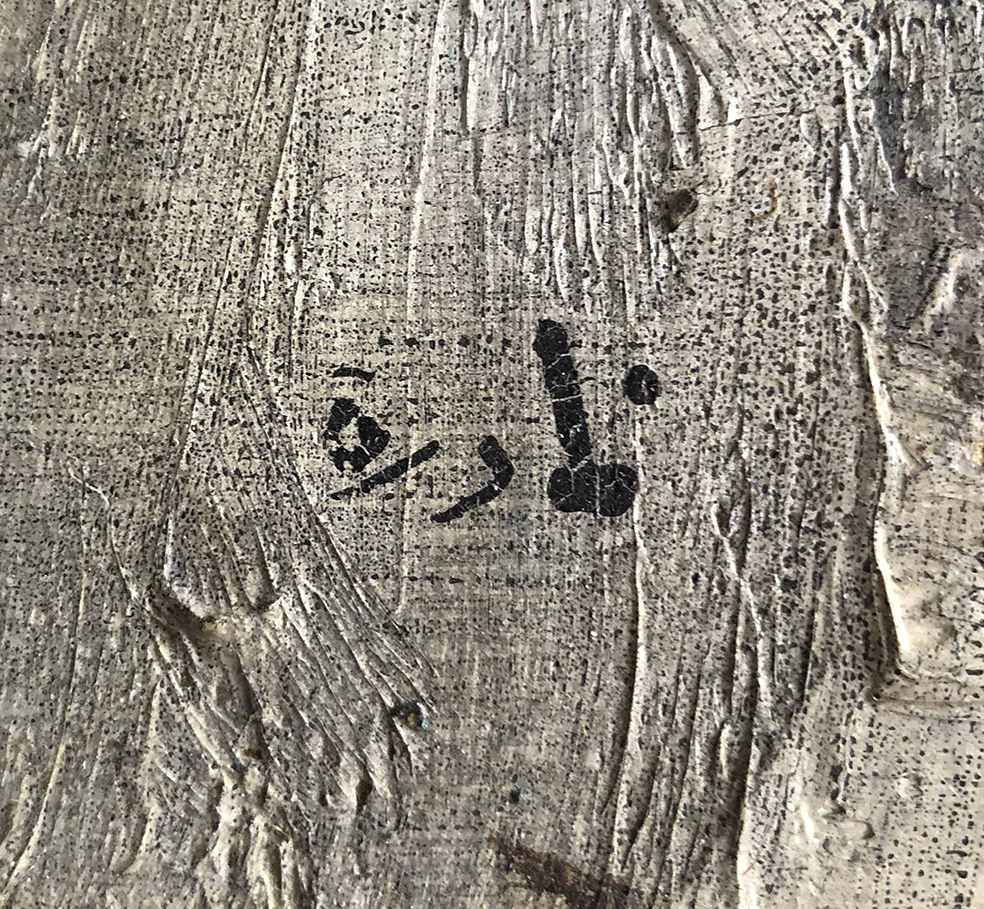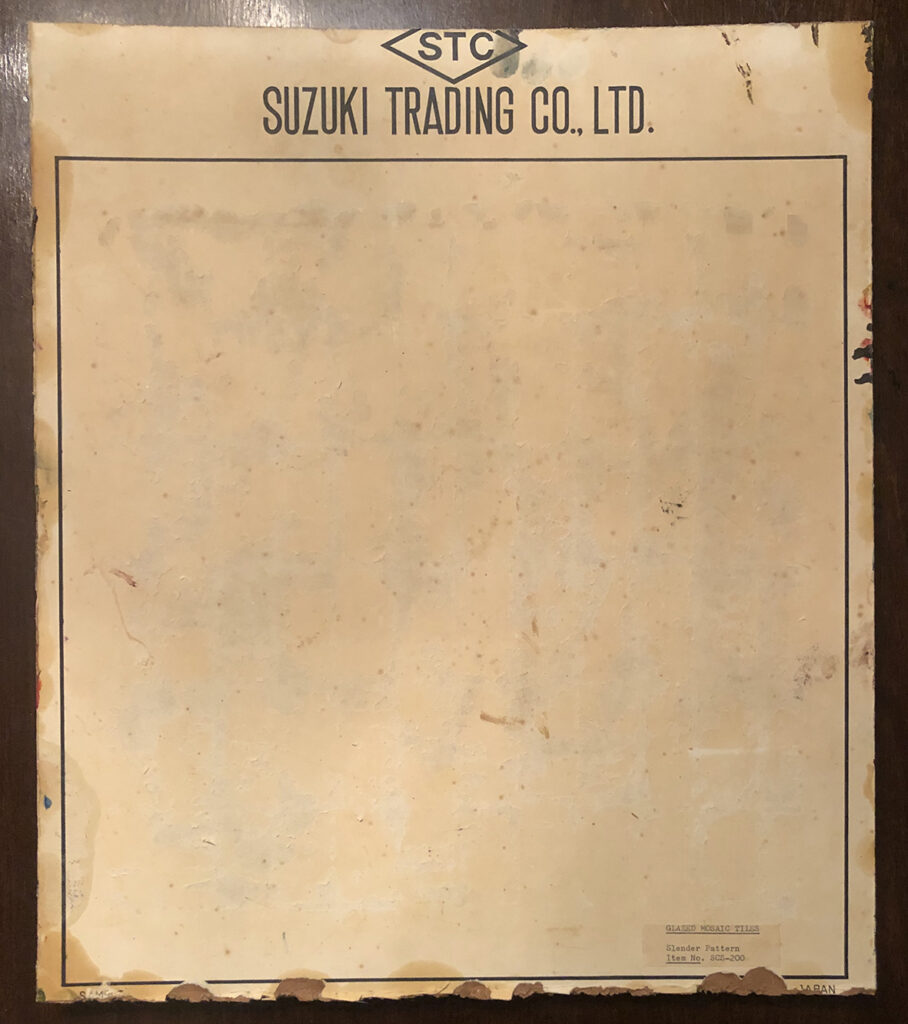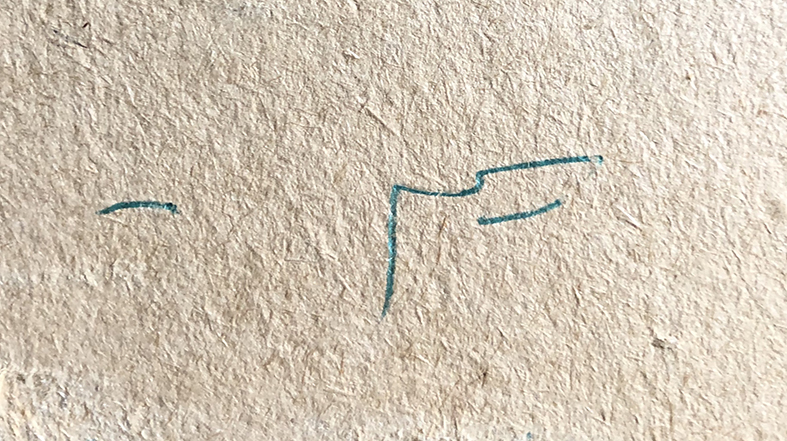
Early in 2020, I bid on and bought a mid-century modern abstract oil on board painting at auction totally sight-unseen, because it looked like it might be the work of an artist I collect right now. Stupid, I know, for all the reasons and especially stupid because, when I went to collect it, it wasn’t by the artist I collect at all. Instead, it bore a signature that was apparently in a different language.
Because I was in the area at the time, I showed it to some dealers I know in the Hampstead Antiques Emporium, and the language was recognised as Persian by two kind Iranian jewellery dealers. The name read Nadereh (or Naderh) – a woman’s name. This may be the name of the artist, as it’s in the right place for that, but it could also possibly be the name of the subject, although I fail to see how this abstract relates to a woman. Maybe I’m not being imaginative enough! A good friend suggested it shows a person seated in a chair drawing or painting a board or canvas. If so, could it be a self-portrait of the artist?

The work itself is jagged, angular, raw, and very thickly painted. The form, marked out in paint, is bulked up in low relief with matches within the paint – an interesting ‘inflammatory’ (?) choice. Highlights in gold and turquoise paint contrast against the earthy black, brown and beige. There’s an almost frenetic dynamism to the paint-laden brushstrokes.

The backboard of the painting bears the same name in Persian and some unreadable (Persian?) characters, written in biro. It was painted onto a cut-down piece of board that once used to hold samples of tiles sold by Suzuki Trading Co., Ltd. Googling that name led me to a Japanese company that exported and distributed timber founded in 1946, and that took on that precise name in 1974. They sold interior panelling (presumably in wood) amongst their products, so it’s not impossible to think that they sold tiles too. It’s also not unusual for painters to pick up discarded materials and use them to paint on, particularly if money was tight.



Following a recommendation from a learned friend, I then asked Janet Rady, who runs a gallery in London specialising in contemporary Arab and Iranian art, and she didn’t know of the artist or recognise the work as in the style of a known artist. She kindly asked her colleagues and contacts for me, and they didn’t know either. I was then going to sell it, but now I’ve decided to keep it. I never like selling anything until I know exactly what it is and what it is worth. But, most importantly, I also rather like it.
First and foremost, I think that it’s a good, mixed media abstract (figural?) picture. Secondly, it’s very representative of the mid-century modern period it almost certainly dates from, specifically the 1960s or 1970s judging by the style. But thirdly, and perhaps most importantly, it appears to have been painted by an Iranian (or Persian) female artist. And that’s really interesting to me.
If it was painted in the mid-late 1970s, and if it was painted in Iran, the country back then was a very different country to what it is now. Under the Shah, the country was cosmopolitan, metropolitan, international, modern – and also highly corrupt, unbalanced, and deeply in recession. As a dear friend who lived there in the 1970s put it, it was also “party city” – if you had money and connections. But the point is, before the Islamic Revolution of 1979, a woman would have had the freedom and ability to paint a modern abstract. After the fall of the Shah, a woman’s life became very, very different in the new Islamic republic during the 1980s and ’90s. And everything about the picture indicates it was certainly painted earlier than the 1990s.
So where did all the art that must have been produced under the Shah’s regime go? Was it burned or destroyed, or merely thrown away? Probably – the Cultural Revolution that began in 1980 fervently purged the country and its inhabitants of all Western and non-Islamic influences. This painting is both non-Islamic and Western in style. If it is by an Iranian woman artist, that puts it into a niche that was probably extremely small, making it an extremely rare survivor. Perhaps it was taken out of the country by one of the many families that fled the revolution? Maybe by the artist herself? Maybe I’ll never know, but the story behind it of that part of our changing world makes it a welcome, powerful and unique addition to my collection.
POSTSCRIPT
Some four years after I bought this painting, I was contacted in March 2024 by a journalist called Ashkan Kalashy, who had seen my blog and kindly spent some time musing on the signatures. He decoded and read them as ‘Nadira’ and then ‘Azzouz’. Fascinating! My Persian friends were so close with the first name!
A quick Google search revealed that Nadira Azzouz (1927-2020) was born in Mosul, Iraq, and studied at The School of Domestic Fine Arts in Baghdad from 1944-49, and then at the Central School of Art in London from 1957-60. She exhibited for decades after in London, Baghdad and also Beirut, where she lived from the 1960s onwards. She built up quite a name for herself, and sounds like a fascinating and strong character. In 1980, she and her husband moved to London, where they settled, although Nadira always missed her native country and the Arab world. In 1988, her work was included in the influential exhibition ‘Arab Women Artists’ at the Kufa Gallery (then run by Rose Issa) in London that showcased the work of leading Arab woman artists.
Janet Rady Fine Art has since had a posthumous exhibition of her work and now represents her estate – you can see the online exhibition by clicking here. There’s also an emotive, passionate and informative obituary written by her son, Mazen Azzouz, for The National News, a major Middle Eastern newspaper, which you can read by clicking here. Her work can be found in prominent international collections, and also in the collection of the Barjeel Art Foundation, Sharjah, United Arab Emirates.
I’m delighted to finally know who my painting is by, especially as it is probably a self-portrait of the artist herself. I’m also very grateful to Ashkan Kalashy for his expertise and kindness.

